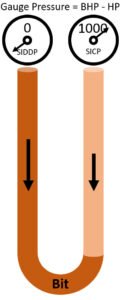Using the U-Tubing Effect for Calculating Top of Cement Once Displaced

The Top of Cement (TOC) is a critical parameter for well integrity, and its accurate estimation is essential for confirming that the cement has reached the desired position in the wellbore. Most regulatory bodies require operators to report the TOC, and various methods exist to calculate this. One of the more complex yet effective approaches is using the U-tubing effect to calculate the TOC after the cement has been displaced.
Typically, the volumetric method is employed for estimating the TOC. This method involves taking into account factors such as annular washout, casing pressure and temperature variations, and fluid loss assumptions based on area-specific excess factors. However, there is an additional consideration—the U-tubing effect—that influences the cement displacement process and plays a role in accurately determining the TOC.
Understanding the U-Tubing Effect
When a liquid cement slurry, often denser than the drilling fluid, is pumped down the casing, it creates a pressure differential in the system. This pressure difference between the casing and the annulus—known as the U-tubing effect—can cause significant changes in the wellbore dynamics. As the slurry is displaced, it creates an imbalance, and if this differential exceeds the system’s friction losses, the cement begins to fall faster than the pump output, causing the well to “go on vacuum.”
During this phase, a gap is formed between the cement and the wellhead, and the slurry accelerates until it reaches an equilibrium point. As the pressure differential gradually reduces, the slurry decelerates, and the gap starts to disappear. This effect can cause significant challenges in monitoring, as it generates false signals that could be misinterpreted by the crew.
Challenges in Monitoring During the U-Tubing Effect
When the cement is “on vacuum,” the pump pressure becomes meaningless. The crew may find themselves unable to control the well pressures effectively, which can lead to confusion. During this phase, the returns often exceed the pump output, which might be misinterpreted as a kick. Similarly, during the deceleration period, when returns are lower than the pump output, this can appear as losses. These fluctuations in pressure and flow can make it challenging to distinguish between normal cement placement behavior and potential well control issues.
Using Pump Pressure to Estimate Top of Cement
Once the cement slurry begins to ascend in the annulus and displacement fluid is pumped down the casing, another U-tube pressure differential is established. This time, however, the pump pressure increases as the slurry’s density causes a difference in hydrostatic pressure between the annulus and the casing. While the pump pressure is influenced by multiple factors—such as pump rate, fluid viscosities, and slurry density—an increase in pressure just before bumping the plug, combined with the pump strokes, can provide valuable information regarding the True Vertical Depth (TVD) of the cement.
By closely monitoring the pressure changes at this stage, operators can get a better indication of the slurry’s placement, allowing for more accurate determination of the TOC. This can be especially useful in cases where other methods of measurement, such as volumetric calculations or direct observation, may be compromised by fluid loss, system friction, or other wellbore anomalies.
Conclusion
The U-tubing effect is a crucial factor in understanding cement placement and can play a significant role in accurately calculating the TOC. By recognizing the impact of the U-tubing pressure differentials, operators can better interpret well pressure data, avoid misinterpretation of well control events, and more effectively monitor the cementing process. This approach enhances wellbore integrity assessments and improves the overall cementing operation by providing real-time insights into the cement slurry’s movement.
For more information on U-Tubing effect on drilling operations, consult my Well Control Manual at: https://learn-well-control.com/product/well-control-manual-by-edwin-ritchie/
